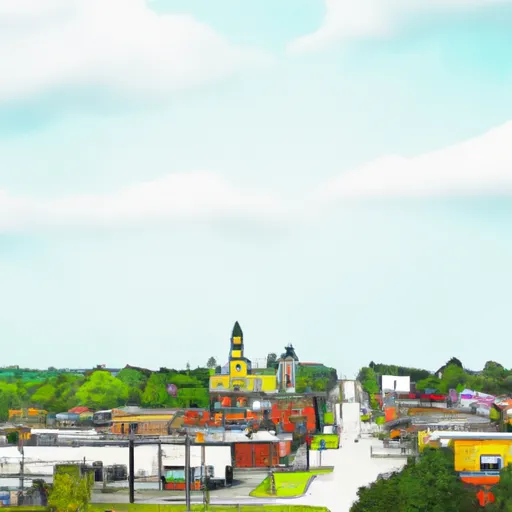-
 Snoflo Premium
Snoflo Premium
Get unlimited access to all our content
With no Ad interruptions! - Start Your Free Trial Login with existing account
Walkerton
Eden Index
Climate
7.7
•
Recreation
4.5
•
Community
2.4
•
Safeguard
5.3/10

Walkerton is a small town located in St. Joseph County, Indiana. It experiences a humid continental climate, characterized by hot, humid summers and cold winters. Average summer temperatures range from 70°F to 85°F, while winter temperatures hover between 20°F and 35°F.
The town's hydrology constituents are primarily influenced by the presence of the Yellow River, which flows near Walkerton. The river provides a water source for the community and supports various aquatic species. Additionally, Walkerton is surrounded by several lakes, including Koontz Lake and Eagle Lake, which provide recreational opportunities such as boating, fishing, and swimming.
Outdoor enthusiasts in Walkerton can also explore the nearby Potato Creek State Park. This park covers an area of 3,840 acres and offers camping, hiking, biking, and horseback riding trails. Visitors can enjoy fishing in Worster Lake or engage in birdwatching, as the park is known for its diverse bird species. The park also features picnic areas, playgrounds, and even a nature center, making it an ideal place for families to enjoy the outdoors.
What is the Eden Index?
The Snoflo Eden Index serves as a comprehensive rating system for regions, evaluating their desirability through a holistic assessment of climate health, outdoor recreation opportunities, and natural disaster risk, acknowledging the profound impact of these factors on livability and well-being.
Climate Health Indicator (CHI): 7.7
Walkerton receives approximately
1015mm of rain per year,
with humidity levels near 81%
and air temperatures averaging around
10°C.
Walkerton has a plant hardyness factor of
5, meaning
plants and agriculture in this region thrive during a short period during spring and early summer. Most
plants will die off during the colder winter months.
By considering the ideal temperature range, reliable water supplies, clean air, and stable seasonal rain or snowpacks, the Climate Health Indicator (CHI) underscores the significance of a healthy climate as the foundation for quality living.
A healthy climate is paramount for ensuring a high quality of life and livability in a region, fostering both physical well-being and environmental harmony. This can be characterized by ideal temperatures, reliable access to water supplies, clean air, and consistent seasonal rain or snowpacks.
Weather Forecast
Streamflow Conditions
Upper Illinois
Area Rivers
Upper Illinois
Snowpack Depths
Upper Illinois
Reservoir Storage Capacity
Upper Illinois
Groundwater Levels
Recreational Opportunity Index (ROI): 4.5
The Recreational Opportunity Index (ROI) recognizes the value of outdoor recreational options, such as parks, hiking trails, camping sites, and fishing spots, while acknowledging that climate plays a pivotal role in ensuring the comfort and consistency of these experiences.
Access to outdoor recreational opportunities, encompassing activities such as parks, hiking, camping, and fishing, is crucial for overall well-being, and the climate plays a pivotal role in enabling and enhancing these experiences, ensuring that individuals can engage in nature-based activities comfortably and consistently.
Camping Areas
| Campground | Campsites | Reservations | Toilets | Showers | Elevation |
|---|---|---|---|---|---|
| OBannon Woods State Park | 280 | 784 ft | |||
| Springs Valley Rec Area | 10 | 672 ft | |||
| Hardin Ridge | 200 | 780 ft | |||
| Tipsaw | 50 | 576 ft | |||
| Paynetown State Rec Area - Monroe Lake | 320 | 557 ft | |||
| Spring Mill State Park | 220 | 670 ft | |||
| Celina Recreation Area | 55 | 709 ft | |||
| Yellowwood State Forest | 80 | 613 ft | |||
| Sycamore Springs Park | None | 490 ft | |||
| Newton Stewart State Rec Area - Patoka Lake | 500 | 728 ft |
Nearby Ski Areas
Catastrophe Safeguard Index (CSI):
The Catastrophe Safeguard Index (CSI) recognizes that natural disaster risk, encompassing floods, fires, hurricanes, and tornadoes, can drastically affect safety and the overall appeal of an area.
The level of natural disaster risk in a region significantly affects safety and the overall livability, with climate change amplifying these risks by potentially increasing the frequency and intensity of events like floods, fires, hurricanes, and tornadoes, thereby posing substantial challenges to community resilience and well-being.
Community Resilience Indicator (CRI): 2.4
The Community Resilience Indicator (CRI) recognizes that education, healthcare, and socioeconomics are crucial to the well-being of a region. The CRI acknowledges the profound impact of these elements on residents' overall quality of life. By evaluating educational resources, healthcare accessibility, and economic inclusivity, the index captures the essential aspects that contribute to a thriving community, fostering resident satisfaction, equity, and social cohesion.

